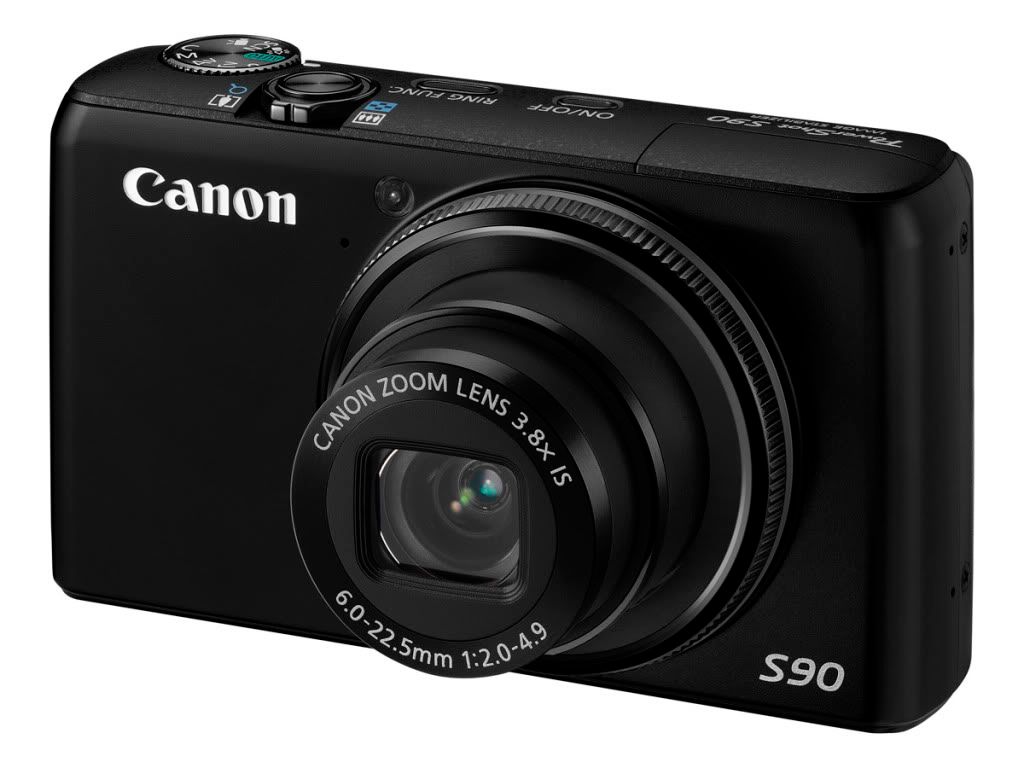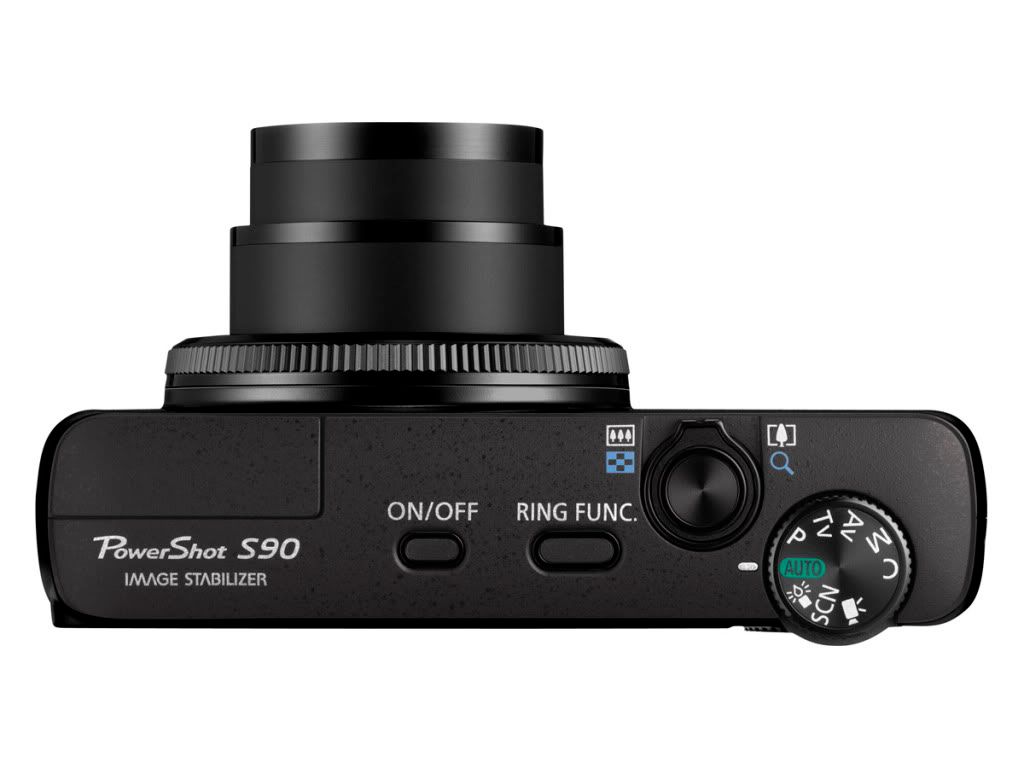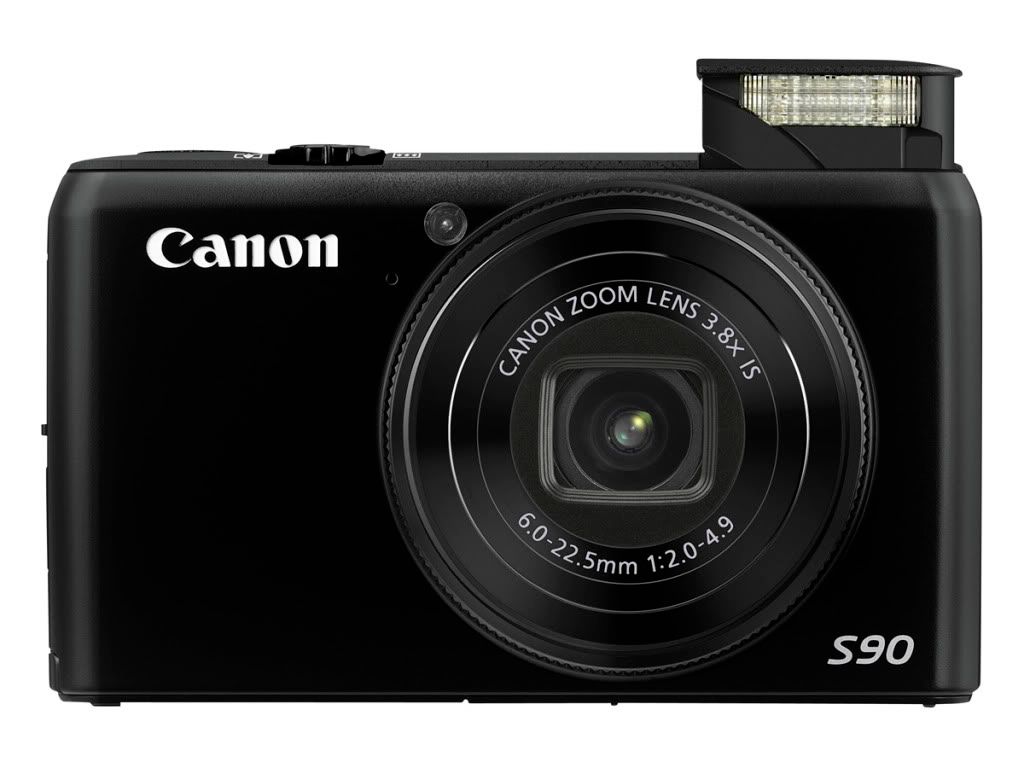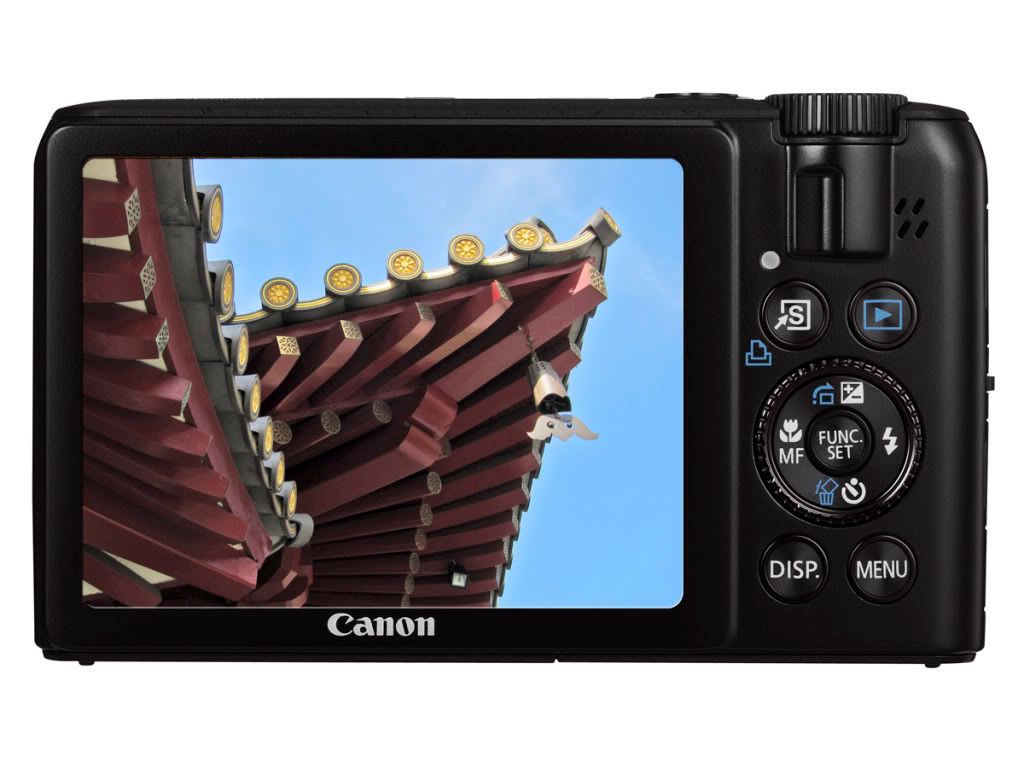While both Canon’s S90 and G11 are targeted at the same serious enthusiast segment, it is clear looking at the design and configuration that both 10MP cameras serve very different purposes. The Powershot G11’s bulky body houses a significantly larger and brighter lens, as well as a hotshoe for external flash control and a rotating LCD. The Canon Powershot S90 on the other hand seems to be focused on streamlining the best features of the high-end Powershot into a sleek body. So what gives? Let’s find out!
About the Canon Powershot S90
The Canon Powershot S90 is designed to fit into the pocket of most jeans, and that compact form factor houses a newly developed High-Sensitivity 10MP sensor and DIGIC 4 image processor. Along with the relatively bright 3.8x zoom lens with a max aperture of f/2.0, the Canon Powershot S90 is designed for impressive low-light photography.
The target audience of the Canon Powershot S90 will be serious photography enthusiasts who want a high-performance compact camera (obviously the G11 is not compact enough) to complement their DSLR kit. It should deliver the maximum quality and level of control for a compact camera, and hopefully mimic some of the performance traits of a DSLR. The target audience is not happy with the dumb point-and-shoot capabilities of the typical compacts, and they will expect more control and quality from the Canon Powershot S90.
Towards that end, the Canon Powershot S90 does feature a 28-105mm (35mm equivalent) lens with a relatively bright aperture of f/2.0 at the wide-end. It features an impressive breadth of features and controls, including the typical PSAM modes found in DSLRs.
Design and construction
The sleek and compact Canon Powershot S90 slides nicely into your jeans pocket, and it extrudes solid feel to the construction. It weighs in at 175g, which is slightly hefty for a compact, but it sits nicely in your hands during shooting.
Yoda said, "Judge me by my size, do you?"
The most obvious feature in the Canon Powershot S90 is the huge control ring that surrounds the lens on the front façade of the camera. This is the first time that Canon has such a feature on a compact camera, and the ring can be customized to set a large number of controls (mind-boggling when you look at the chart in the manual!). Use it to set preset focal lengths (28mm, 35mm, 50mm, 85mm and 105mm), ISO speeds, aperture settings, shutter speed or even to focus manually. It has nice detents for smooth click-stops, which makes it easy to use.
The mode dial that sits on top of the camera near the shutter release button controls the exposure modes, and it too feature a nice click-stop motion and ribbed circumference that makes it easy to change modes.
The camera is far from perfect though. The flash pops up from the camera - in the wrong position! It is very easy to obscure the flash by finger, and you might either damage the flash motor in the long run, or surprise of the flash’s motorized rise may cause you to drop the camera in confusion.
Jack-in-a-box flash: unnecessary surprises
But that is a small issue compared to the design of the control dial behind the camera. The little wheel spins freely where your right thumb is holding the camera, and it is very easy to accidentally spin the confounded wheel. What is even more unbearable is that the action causes the camera to go into exposure compensation, sending your images into wild over or under exposure. Canon could have incorporated click-stops into the control wheel as well to prevent such unintended consequences.
The control dial of endless grief... why?!
As a counter-measure, I configured the control dial to control the aperture instead of the exposure compensation, so that the images will not be screwed up accidentally by a slight brush of the wheel against the right thumb or anything else. It is not the ideal solution, but I’d rather have a less than ideal aperture setting than unintended exposure compensation!
Overall the Canon Powershot S90 gives you confidence with a solid construction, but the form factor can be greatly improved with respect to the free spinning control dial and pop-up flash
Focusing
The autofocus capability of the Canon Powershot S90 is good for a compact, but it is nothing to write home about. Without technical measurements, it is difficult to say for sure, but it felt no different from a typical Canon Powershot camera (which is not bad really). However, if you need the split second snap focus response of a DSLR for street photography, the Canon Powershot S90 may disappoint with the focusing and shutter lag. But not to worry though, there are workarounds that I will explain later in this review.
The camera lets you check for focus accuracy visually by magnifying the focus spot on the LCD (Canon calls it AF-point Zoom). And if you run into situations where the camera keeps focusing on the adjacent subject instead of what you really intended, you can switch to a smaller AF frame size for increased focusing accuracy. Servo AF is also available for continuous focus and subject tracking.
Nice details and tonality (click to enlarge)
Nice details and tonality (click to enlarge)
You can focus manually with the Canon Powershot S90, but the camera does not indicate the exact range (there’s a indicator bar marked with approximate distance though). You should use the magnified view of focus square to assist in manual focusing. Overall, the operation design lets you focus manually in a leisurely manner, but fast manual focusing is out of the question. It helps however, when you are shooting through glass or fences (and the autofocus gets all confused).
Noise control
The noise control in the Canon Powershot S90 is impressive though. For low-light photography up to ISO 800, the resulting images are very good for a compact camera. For pixel peepers, the ISO 1600 setting is useable in emergencies, but details are mushy in ISO 3200. The DIGIC processor does an impressive job of keeping the noise level in check while maintaining the details in the image.
Image shot at ISO 1600
Enlarged (100%) version of the image (ISO 1600)
The Canon Powershot S90 does feature a Low light mode that automatically sets ISO between 320 to 12800! It sounds good until you realize that your images are restricted to M quality or 2.5MP. That’s not really something you’d want in a 10MP camera.
Battery life
The Canon Powershot S90 is powered by a NiMH battery rated at 1000mAH. While I can’t really complain about the battery life (the low-battery warning came on at 207 shots, I was expecting more from a high-end compact camera. The battery is certainly enough for a day’s shooting or a night in town, but I’d definitely pack a couple more batteries for an overseas trip though.
Macro quality
The macro quality of the lens is pretty good on the Canon Powershot S90. With a minimum focusing distance of 5cm at the wide end of the lens, you can achieve good close-up images for objects measuring the size of a credit card. However, because you’re shooting with a 28mm focal length at that setting, the perspective can be a bit strange. Zoom it to 50mm focal length for larger subjects, and everything looks good. The Canon Powershot S90 delivers great quality macro photos in terms of sharpness.
A sinking feeling (click to enlarge)
Maximum macro - 5 cm away from a short circuit (click to enlarge)
White balance
White balance has always been a weakness of many cameras, and the Canon Powershot S90 delivers above average performance. It manages to turn in good auto white balance performance, although some warm fluorescent lighting still throws off the white balance (interestingly the S90 has two settings for fluorescent which should make it more accurate). One nice touch about the Canon Powershot S90 is the ability to do custom white balance setting in any white balance modes – you can manually shift the white balance to fine-tune it. There is even a custom white balance that you can set by referencing the camera against a white subject in the light you’re shooting in.
Other features
The Canon Powershot S90 shoots movies up to approximately 1 hour in length or when card is full (whichever comes first). Try to use Class 4 SD cards as recommended by Canon when shooting video to ensure a high write-rate. One slight disappointment is that the Canon Powershot S90 does not offer HD movie recording, which I had expected from a high-end digital compact.
You can set the playback screen to show a lot of details, indicating ISO and exposure settings (aperture and shutter). It even indicates exposure compensation, metering pattern used and special settings (such as macro modes). There is also a histogram of the values, and over-exposed areas in the image blink to warn you of blown-out highlights.
Manual control gives you creative options - even with flares!
Continuous shooting possible is possible with the Canon Powershot S90, but only up to 0.9 image per second (which is better than nothing). The shutter speed settings run from 15” to 1/1000th sec, while being pretty decent still trails behind the G11’s 1/4000th top shutter speed).
Control over shutter speeds is useful (click to enlarge)
While the Canon Powershot S90m (seemingly) offers you control of both aperture and shutter speeds, I felt the aperture was really not much of a control in the end. The camera offers a limited aperture range of f/2 to f/8, and that is only at the 28mm end. By the time you reach 105mm, you only have a max aperture of f/4.9, leaving you just slightly more than a stop to play with!
You can’t really use the S90 to isolate details with a shallow depth of field as you imagined. The f/2.0 aperture only exists with a 28mm focal length setting, and with such a wide-angle and a small sensor, the image still appears with a good dose of depth of field even at f/2.0. You can probably minimize the depth-of-field by shooting close-ups, but that restricts the usefulness of the camera. Where the f/2.0 shines though, is the ability to shoot in low-light situations at 28mm, which brings us to our next section – street photography with the Canon Powershot S90.
Street photography with the Canon Powershot S90
When it comes to street photography, photographers are almost unanimous in what they want in a camera - a sleek, stealthy and responsive camera with a fast lens to capture the scenes in the street.
We know that the black and sleek Canon S90 is sleek and stealthy, and it ships with a fast lens (at 28mm at least). So is it responsive enough to be a good street photography camera?
Checkmate! (click to enlarge)
If there’s something that street photographers dread in a camera, it is shutter lag. Events and moments happen in a split-second during street photography, and shutter lag simply means that you are not getting the shot at all. And for the first 15 minutes in the street, I simply wasn’t getting anything at all!
The shutter lag of the Canon Powershot S90 leaves something to be desired at default setting. You can’t react and shoot in split-seconds using the Canon S90 in the street. The camera isn’t slow for a compact, but the precious milliseconds it takes to focus and then fire is enough for your subject to leave the frame, especially if you are used to DSLR or rangefinder performance.
Chinatown grandmasters deep in thought (click to enlarge)
Fortunately, the camera offers a plethora of settings to customize its functions, which help to side-step some of its shortcomings. By setting it to manual focus, the shutter lag is reduced considerably, and you can pre-focus your subject distance (the small sensor and 28mm focal length makes the camera pretty forgiving with its depth-of-field).
You can set it to continuous shooting, and set the ISO to Auto ISO to give the camera more free play in changing light levels. I usually prefer to shoot in Aperture Priority mode, plus the limited selection of aperture means it’s more feasible to shoot in Aperture Priority mode because the camera has more shutter speeds to select from compared to aperture settings!
Set to manual focus for minimum shutter lag (click to enlarge)
For the finishing touches, disable the flash, mute all sounds and the AF assist beam in the menu settings, and you’d make the Canon Powershot S90 a truly stealthy street photography camera!
Conclusions
At the end of the day, there's no doubt that the Canon Powershot S90 is an accomplished and polished compact digital camera, capable of delivering very good results especially in terms of high-ISO performance. That said, the Canon S90 retains many of the traits (read: weakness) of compact cameras which cannot yet match up to a bona-fide DSLR. The lightweight and compact size makes it easy to carry around, but the lack of space for controls mean more steps in setting functions, making it more complex and slower to use. The AF speed lags behind DSLRs for critical split-seconds street photography, and while the manual settings are a welcome addition to a compact camera, the limited breadth of aperture range makes it less useful than it seems.
ISO 1600 on a compact? Click to check out the details!
However, if you consider the progress made by the Canon Powershot S90, you'd understand the tremendous strides made by Canon in delivering the quality and controls in a compact camera. It is now possible to capture good photos in dim environments with a compact camera, and there are various work-around methods to resolve the shutter-lag issue. The Canon Powershot S90 may not be the perfect camera, but keep in mind that it is not a DSLR, but rather a high-performance compact camera that stays in your pocket - ready to capture scenes that you'd might otherwise miss with your DSLR that stayed at home.

















2 comments:
r4 dsi
GREAT photo quality, lots of features, easy navigation of features, finally the return of flippable LCD back screen as with her old Powershot, great low light noiseless pics of children! It has a viewfinder rather than just the screen.
great review and cool site bro...
my short take on what fits my needs for the compacts here...
http://timetapestry.blogspot.com/2009/12/deciding-on-decent-compact-canon-g11-vs.html
Post a Comment